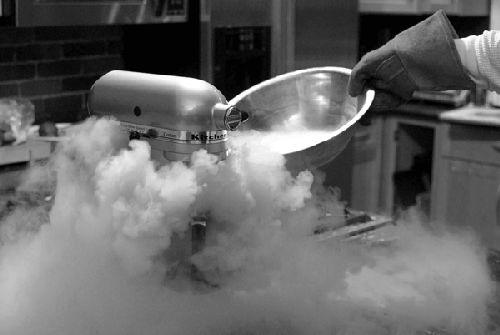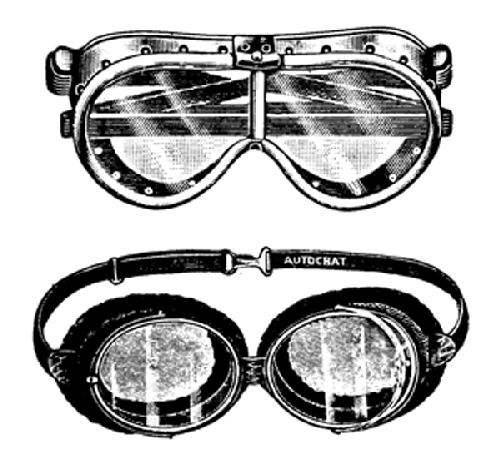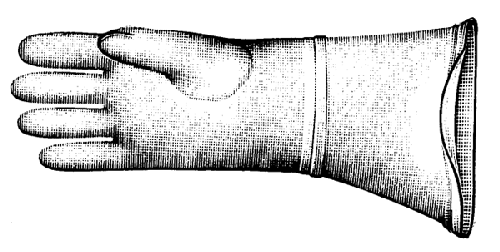3.2. Making dusts
One of the classic “silly things you can do with liquid nitrogen” tricks is to
freeze a leaf or a rose and then whack it against something to shatter it. Unlike
traditional methods of freezing, liquid nitrogen freezes the water in the plant so
quickly that the ice crystals do not have time to aggregate into crystals large enough
to pierce the cell walls and destroy the tissue, meaning the leaf or flower won’t wilt
when thawed.
In culinary applications, you can use this same
property to create “dust” from plant material. Lavender flowers, for example, can be
rapidly frozen, crushed with a mortar and pestle (which needs to be chilled in a freezer
to keep the frozen plant material from thawing), and then allowed to thaw back out. Some
chefs have frozen larger items—beets, for example—causing them to shatter in an organic
pattern that couldn’t be obtained with a knife.
3.3. Making ice cream

The standard formula for LN2 ice cream goes something like
this: cream + flavoring + liquid nitrogen + whisking / mixing = 30-second ice
cream.
While you can make ice cream with a small quantity of alcohol using traditional
methods, those versions have only a mild flavor brought by the alcohols, which are used
more as extracts or flavorings than as actual components of the body. With liquid
nitrogen, however, you can make a scoop of ice cream with an entire shot of alcohol.
Calories are no longer the biggest problem with this type of ice cream; hangovers
are.

As with anything you make with liquid nitrogen that’s served cold, check to make
sure that it’s not too cold before serving it. An IR thermometer is
a handy tool for this. Spot-check your ice cream, and if it’s too cold, let it warm up
to normal freezer temperature.
In the metal bowl of a stand mixer, mix: 1 cup (256g) milk 1 cup (240g) heavy cream ¾ cup (180g) Goldschläger (cinnamon
liqueur) ¼ cup (80g) chocolate syrup ½ cup (80g) bittersweet chocolate,
melted 2 tablespoons (25g) sugar ½ teaspoon (1g) salt ½ teaspoon (1g) cinnamon
Taste the mixture to check the balance (try not to drink it all at this point),
and adjust accordingly. Once frozen, the mixture will not taste as strong, so an
overly strong mixture is desirable. Turn your stand mixer on and (carefully! with goggles and gloves!) slowly pour in
liquid nitrogen. I find it takes about a 1:1 ratio of mixture to liquid nitrogen to
set the ice cream. If you don’t have a stand mixer, you can also do this in a metal
bowl and stir with a whisk or wooden spoon. 
Note To melt the chocolate, microwave the milk and then add the chocolate
to the hot milk. Let it rest for a minute, so the chocolate warms up, and then
mix to combine. You can nuke the chocolate directly as well, but I find it
easier and less likely to burn doing it this way.
|
Dry
ice—solid carbon dioxide—is easier to work with than liquid nitrogen. For one thing,
it’s solid, so you don’t need specialized equipment to handle it. A Styrofoam cooler
or even a cardboard box is sufficient. And secondly, it’s much more readily available.
Just make sure to ask for food-grade dry ice! A few words of warning: like liquid nitrogen, dry ice expands into a much larger
volume as it sublimates. Do not store dry ice in a sealed container. Also, dry ice and
ethanol form a wet slurry that is very dangerous. It’s not cold
enough to generate the Leidenfrost effect, the phenomenon where a liquid generates a
vapor barrier around a much-hotter item. Dry ice and ethanol can wick through clothing
and stick to skin. Besides sticking a chunk of dry ice in a cup of coffee and pretending not to
notice while drinking from it (the chunk will sink to the bottom), what else can you
do? Quick-freeze berries. Industry lingo for this
is IQF (individually quick frozen), in which large blast freezers
rapidly freeze individual peas, raspberries, and chicken breasts. You can toss some
dry ice in a Styrofoam cooler and mix in a roughly equal amount of berries or veggies,
wait until the dry ice has sublimated away, and then bag ’em and stick them in the
freezer. Make ice cream. Works just like liquid
nitrogen, only alcoholic flavors probably won’t set quite as nicely. Take your
food-grade dry ice, place it between two towels, and give it a few whacks with
something like a rubber mallet or the back of a frying pan to create a powder. Whisk
the powder into the ice cream base until set.
Note: As with LN2 ice cream, it’ll take a little less dry ice
if you start with a base already at freezing temperatures.
Create “fizzy fruit.” Drop some grapes,
bananas, strawberries—really, any moist fruit—into a pressure cooker, toss in some dry
ice, and slap on the lid. As the dry ice sublimates, the chamber of the pressure
cooker will hold the carbon dioxide (and bleed off any over-pressure amount), and the
fruit will absorb some CO2. Wait 20 to 30 minutes, release the
pressure, pop off the lid, and munch away. |